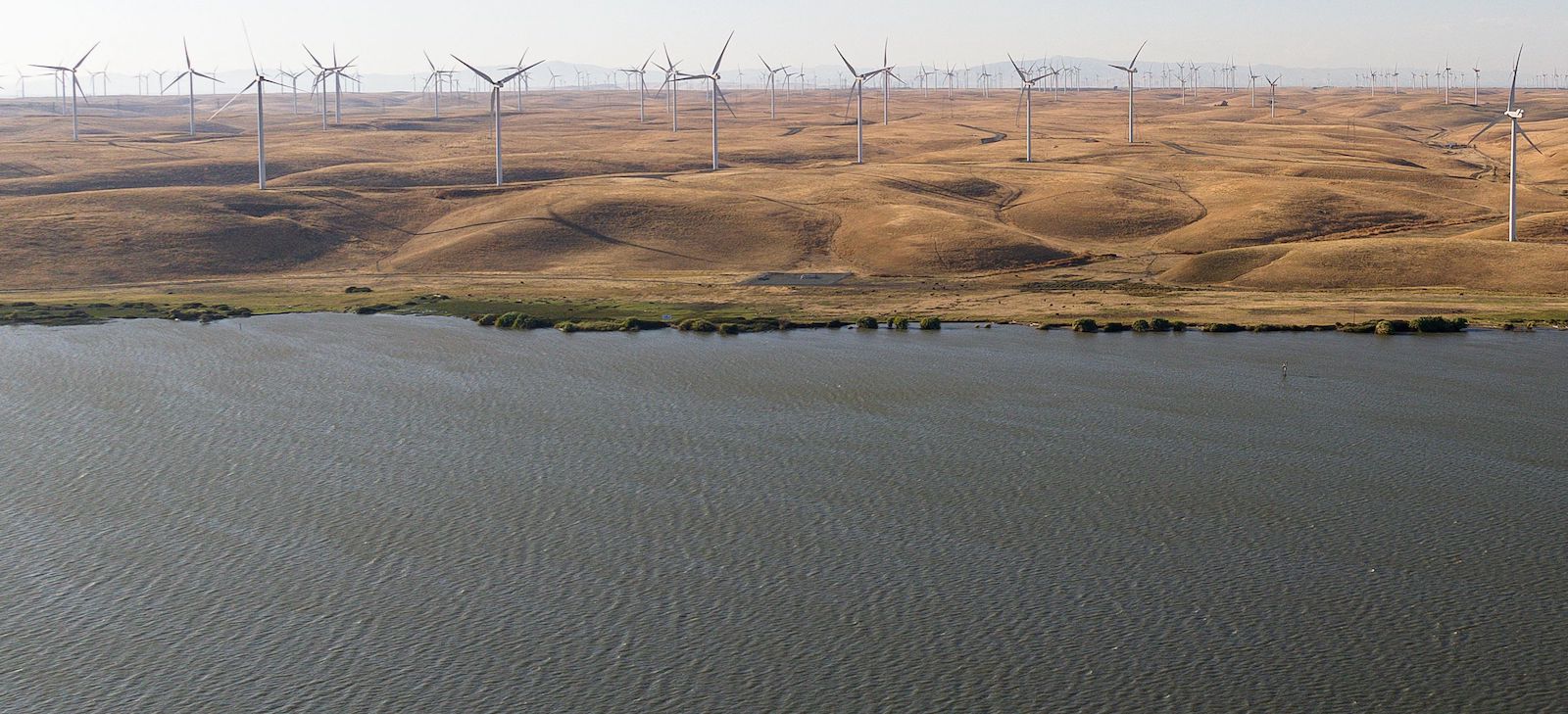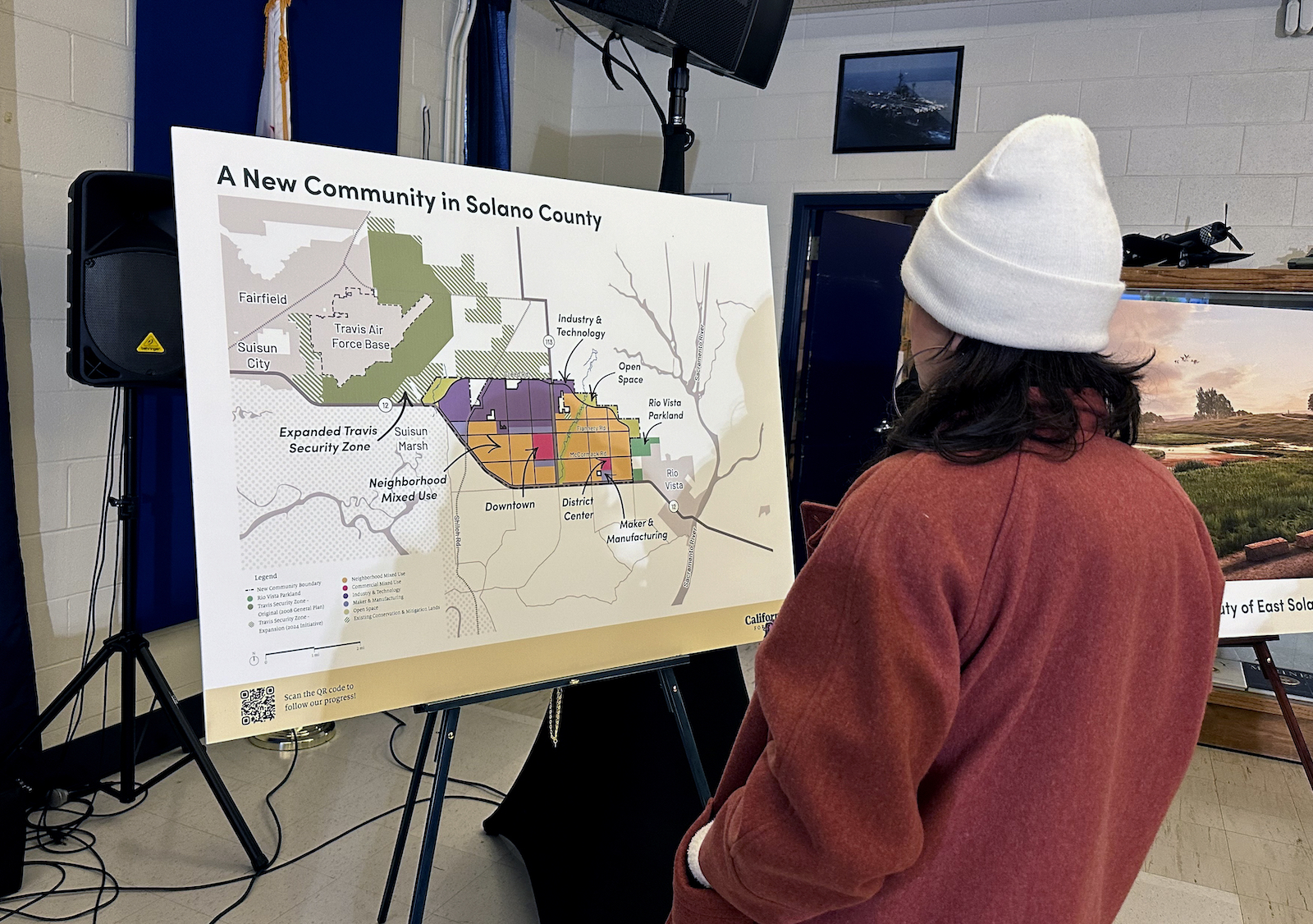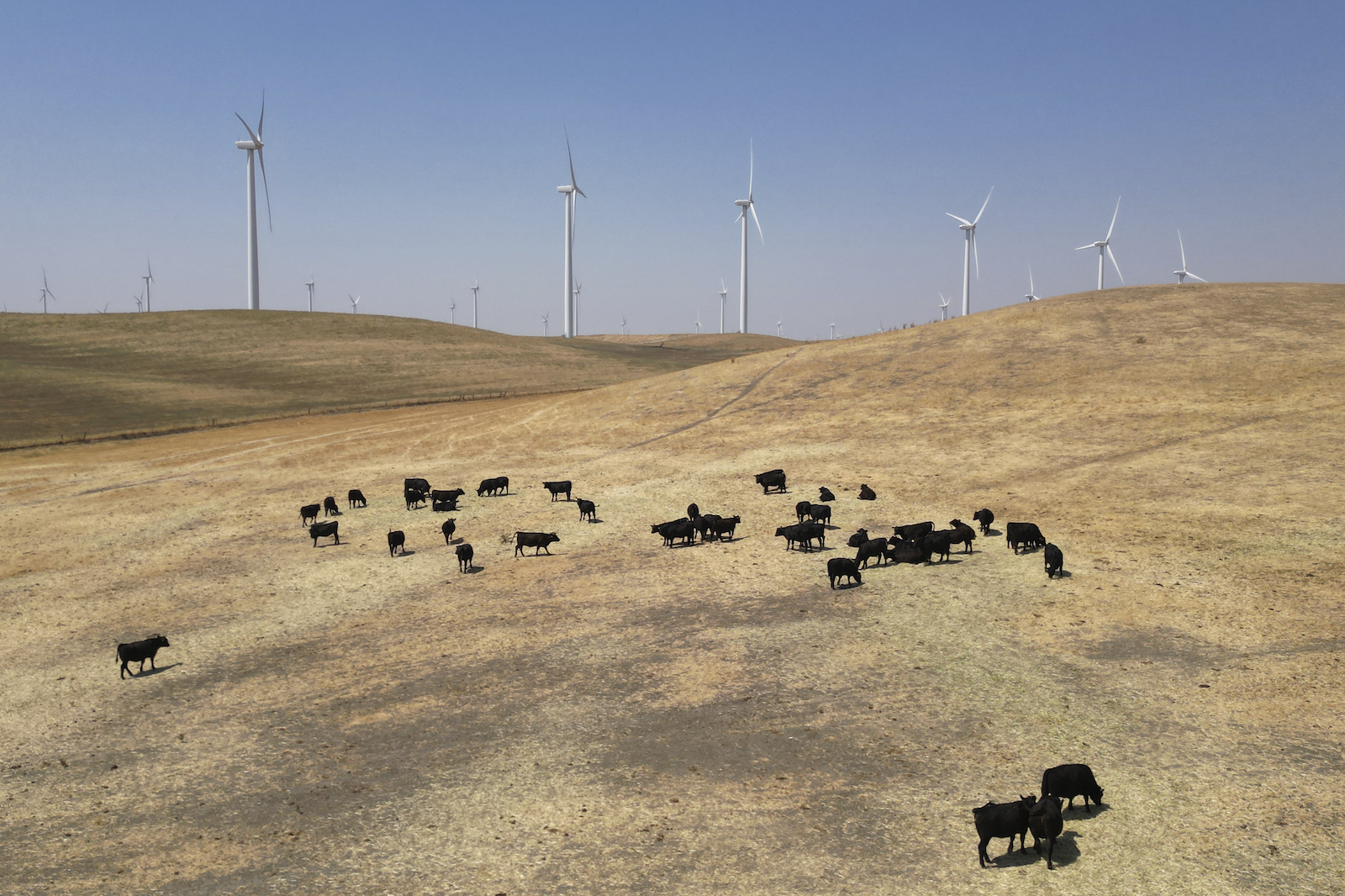Is it possible to build a dream city from scratch?
In 2018, a company began quietly buying up some $900 million worth of land from farmers in Solano County, California, an area just north of the Bay Area. As the parcel ballooned to more than 60,000 acres, their motivations remained a mystery — stoking unease and speculation. Then, last year, the news broke: The land was to become a brand-new eco-friendly city, backed by a roster of Silicon Valley billionaires, and built from the top-down by a company called California Forever. The plan was launched by Jan Sramek, a former Goldman Sachs trader and California Forever’s CEO. He said the project has three main goals: “Help solve the California housing crisis”; create a walkable metropolitan area with a high quality of life and low carbon footprint; and build a new “economic engine” for Solano County. “There’s no playbook here,” Sramek said. “What we are trying to do is really, really different.” Before California Forever could break ground, their proposal, the East Solano Plan, needed approval from the people who already live in Solano County. Where Sramek envisioned growth, however, others warned of irreversible ecological damage. Despite launching a multimillion-dollar campaign to persuade the public to vote for the proposal in the upcoming November election, concerns continued to grow as elected officials began speaking out in opposition, and a coalition against the project formed. Local mistrust was further deepened by the company’s ongoing lawsuit against landowners who resisted their offers. In April, a poll showed that 70 percent of Solano’s voters would likely reject the measure. Jan Sramek, founder and CEO for California Forever, talks to reporters after a news conference for the proposed new city in Solano County, in Rio Vista, California in January 2024. Janie Har / AP Photo On July 22, the day before the Solano County Board of Supervisors was set to decide whether to put the initiative on the November ballot, Sramek and the board agreed to retract the proposal. According to a joint statement announcing the decision, Sramek said that California Forever will try to get it on the ballot again in two years, after a report assessing the environmental impacts of the project is finished. Other similarly minded and deep-pocketed projects have been springing up around the world. Masdar, a $20 billion planned zero-carbon city in the United Arab Emirates, has been delayed for decades and scaled back beyond recognition. Neom, the futuristic $500 billion renewable energy dream of Saudi Arabian royals, now anticipates less than a fifth of the 1.5 million residents they originally planned on. Malaysia’s Forest City, which won design awards for sustainability, has been called a ghost town. And the billionaire behind Diapers.com has big plans for Telosa somewhere in the deserts of the American West, a sprawling green energy metropolis. These projects all seek to fulfill urban dreams of a better, environmentally friendly life by building a city from scratch. But even when the buildings exist, they fail to draw residents and, despite plans that emphasize sustainability, projects struggle to win the support of environmentalists. California Forever hopes to eventually house 400,000 people — goals comparable to those of Masdar or Neom. “I have not seen one of this size which has been successful so far,” said Alain Bertaud, an urban planning researcher at the Marron Institute, part of New York University. “But that doesn’t mean that they will not be — there are so many in the pipeline now.” Though Bertaud said he’s normally skeptical of proposals for these new cities, he thought California Forever’s plans looked well designed. One aspect that could help the project find success is its proximity to other Bay Area cities, he said, as the lure of the region’s job market might encourage people to move there. A parcel of land recently purchased by Flannery Associates as part of plans for “California Forever” is seen near the Sacramento River near Rio Vista, California on September 15, 2023. Josh Edelson / AFP via Getty Photos But when it comes to the project’s environmental promises, he’s unconvinced — if only because it’s difficult to measure benchmarks, like carbon emissions, until a project is up and running. “I don’t doubt the dedication of people who are fighting for sustainability,” he said, “but unless you define it in a very clear way, I’m afraid that ‘sustainability’ is a self-satisfying slogan to put on whatever idea you have.” The question of sustainability is at the heart of California Forever’s ambition and problems alike. Both backers and skeptics want to tackle the area’s housing crisis. Eye-popping rents and home prices far exceed national averages, with single-family homes going for a median price of $1.4 million. It’s one reason why the region has the third-highest homeless population behind New York City and Los Angeles. Instead of solving these problems with a new city, California Forever’s critics would like to see more housing built in the seven cities that already exist in Solano County. “Building housing in existing communities is one of our best climate solutions, and paving over 17,000 acres of non-irrigated farmland is not,” said Sadie Wilson, director of planning and research at the Greenbelt Alliance. The nonprofit, along with the Center for Biological Diversity and the California Sierra Club, is one of the 16 groups in Solano Together, the coalition that opposes the project. A person examines a map of the proposed community “California Forever” in Solano County, California during a news conference in Rio Vista, California, on Jan. 17, 2024. Janie Har / AP Photo Wilson says that the development threatens both the area’s potential for storing carbon in the soil and local biodiversity, and also risks leading to more pollution from people driving to work in nearby cities. And although California Forever holds water rights that could support the first 40,000 residents, Solano Together says that these don’t accurately reflect water availability. Securing a reliable supply, they argue, would be challenging in a region so prone to drought. By starting from scratch, however, California Forever says their plans could avoid the baggage of urban problems like car-centric design and gas utilities, making it easier to support dense housing and run on renewable power. “Our plan will be the lowest per capita carbon emissions anywhere on the planet. It’s going to be pretty transformational,” said Bronson Johnson, the company’s head of infrastructure and sustainability, who added that he’s spent years grappling with barriers to retrofit existing cities. “I think when we look at the greater good of this project, that far outweighs local impacts,” Johnson said. But the voters need convincing. After The New York Times named many of the investors behind the project — including Reid Hoffman, a LinkedIn cofounder, and Michael Moritz, a prominent venture capitalist — in August 2023, California Forever began working to bring residents over to their side in time for the 2024 election. By May, the company had spent some $2 million on its campaign and gathered enough signatures to qualify their initiative for the ballot. In weeks leading up to the Solano County board meeting in July, an economic report by the business-backed Bay Area Council touted the potential jobs and housing benefits, saying that the county could increase employment in high-earning sectors by 53 percent. Meanwhile, the company proposed putting a lagoon right in the middle of the new town, “open to everyone from Solano County.” Read Next Pipe dreams: Why far-fetched Western water projects won’t go away Jake Bittle Five days before the meeting, the county released its own assessment that said the initiative lacked details on key issues, such as infrastructure funding, traffic impacts, and water supply. Many of these unknowns would be clarified by an environmental impact report required under California law, which the company had said it planned to conduct after residents voted. According to county officials, it was this omission, and the lack of a binding development agreement, that ultimately tanked the proposal. “This politicized the entire project, made it difficult for us and our staff to work with them, and forced everyone in our community to take sides,” said Mitch Mashburn, chair of the Solano County Board of Supervisors, in the statement announcing that the plan would be put on hold. According to the statement, Sramek and Mashburn came to the decision together after agreeing that the timing of the proposal had become unrealistic. “I want to acknowledge that many Solano residents are excited about Mr. Sramek’s optimism about a California that builds again. He is also right that we cannot solve our jobs, housing, and energy challenges if every project takes a decade or more to break ground,” Mashburn said in the statement. Cattle graze on a hillside with wind farms in the background in rural Solano County, near the proposed development site of California Forever, in August 2023. Terry Chea / AP Photo Solano Together heralded the news as a win. Wilson said that even though an environmental impact report would clear up many of the coalition’s questions, especially around water supply, the location of the development still poses what she considers an intractable environmental problem. “It is a vibrant landscape that supports our food systems, our environment, our water systems,” she said. Sarah Moser, an urban geography researcher at the University of McGill in Montreal, said it makes sense that sparsely populated agricultural lands and deserts are appealing for mega developments like the proposed East Solano Plan because they’ll encounter less opposition. But by building on undeveloped land, “by definition, you’re going to incur a carbon debt that you may never be able to pay off,” she said. Although Moser thinks it’s logistically possible to build a city from scratch, she says that such projects are increasingly high risk, with unattainable goals. “You can make affordable housing, or you can make money, but you can’t do both,” Moser said, adding that California Forever’s for-profit model fits into a broader pattern of “rich people getting richer” in the urban mega developments she has studied. And perhaps the most important ingredient necessary to successfully build a new city is the very thing that stands in the way: people. The promise of a city built on ideals isn’t enough to fill it with people, Bertaud said. There has to be an existing community of people, culture, entertainment, and jobs that draw people there. It’s a chicken-or-egg problem unique to starting from scratch. “Why would you go to a city where there is nobody?” he said. This story was originally published by Grist with the headline Is it possible to build a dream city from scratch? on Aug 1, 2024.
Sustainability is at the heart of California Forever’s ambitious plan for a new city — and its problems.
In 2018, a company began quietly buying up some $900 million worth of land from farmers in Solano County, California, an area just north of the Bay Area. As the parcel ballooned to more than 60,000 acres, their motivations remained a mystery — stoking unease and speculation. Then, last year, the news broke: The land was to become a brand-new eco-friendly city, backed by a roster of Silicon Valley billionaires, and built from the top-down by a company called California Forever.
The plan was launched by Jan Sramek, a former Goldman Sachs trader and California Forever’s CEO. He said the project has three main goals: “Help solve the California housing crisis”; create a walkable metropolitan area with a high quality of life and low carbon footprint; and build a new “economic engine” for Solano County. “There’s no playbook here,” Sramek said. “What we are trying to do is really, really different.”
Before California Forever could break ground, their proposal, the East Solano Plan, needed approval from the people who already live in Solano County. Where Sramek envisioned growth, however, others warned of irreversible ecological damage. Despite launching a multimillion-dollar campaign to persuade the public to vote for the proposal in the upcoming November election, concerns continued to grow as elected officials began speaking out in opposition, and a coalition against the project formed. Local mistrust was further deepened by the company’s ongoing lawsuit against landowners who resisted their offers. In April, a poll showed that 70 percent of Solano’s voters would likely reject the measure.

On July 22, the day before the Solano County Board of Supervisors was set to decide whether to put the initiative on the November ballot, Sramek and the board agreed to retract the proposal. According to a joint statement announcing the decision, Sramek said that California Forever will try to get it on the ballot again in two years, after a report assessing the environmental impacts of the project is finished.
Other similarly minded and deep-pocketed projects have been springing up around the world. Masdar, a $20 billion planned zero-carbon city in the United Arab Emirates, has been delayed for decades and scaled back beyond recognition. Neom, the futuristic $500 billion renewable energy dream of Saudi Arabian royals, now anticipates less than a fifth of the 1.5 million residents they originally planned on. Malaysia’s Forest City, which won design awards for sustainability, has been called a ghost town. And the billionaire behind Diapers.com has big plans for Telosa somewhere in the deserts of the American West, a sprawling green energy metropolis.
These projects all seek to fulfill urban dreams of a better, environmentally friendly life by building a city from scratch. But even when the buildings exist, they fail to draw residents and, despite plans that emphasize sustainability, projects struggle to win the support of environmentalists. California Forever hopes to eventually house 400,000 people — goals comparable to those of Masdar or Neom.
“I have not seen one of this size which has been successful so far,” said Alain Bertaud, an urban planning researcher at the Marron Institute, part of New York University. “But that doesn’t mean that they will not be — there are so many in the pipeline now.”
Though Bertaud said he’s normally skeptical of proposals for these new cities, he thought California Forever’s plans looked well designed. One aspect that could help the project find success is its proximity to other Bay Area cities, he said, as the lure of the region’s job market might encourage people to move there.

But when it comes to the project’s environmental promises, he’s unconvinced — if only because it’s difficult to measure benchmarks, like carbon emissions, until a project is up and running. “I don’t doubt the dedication of people who are fighting for sustainability,” he said, “but unless you define it in a very clear way, I’m afraid that ‘sustainability’ is a self-satisfying slogan to put on whatever idea you have.”
The question of sustainability is at the heart of California Forever’s ambition and problems alike. Both backers and skeptics want to tackle the area’s housing crisis. Eye-popping rents and home prices far exceed national averages, with single-family homes going for a median price of $1.4 million. It’s one reason why the region has the third-highest homeless population behind New York City and Los Angeles.
Instead of solving these problems with a new city, California Forever’s critics would like to see more housing built in the seven cities that already exist in Solano County. “Building housing in existing communities is one of our best climate solutions, and paving over 17,000 acres of non-irrigated farmland is not,” said Sadie Wilson, director of planning and research at the Greenbelt Alliance. The nonprofit, along with the Center for Biological Diversity and the California Sierra Club, is one of the 16 groups in Solano Together, the coalition that opposes the project.

Wilson says that the development threatens both the area’s potential for storing carbon in the soil and local biodiversity, and also risks leading to more pollution from people driving to work in nearby cities. And although California Forever holds water rights that could support the first 40,000 residents, Solano Together says that these don’t accurately reflect water availability. Securing a reliable supply, they argue, would be challenging in a region so prone to drought.
By starting from scratch, however, California Forever says their plans could avoid the baggage of urban problems like car-centric design and gas utilities, making it easier to support dense housing and run on renewable power. “Our plan will be the lowest per capita carbon emissions anywhere on the planet. It’s going to be pretty transformational,” said Bronson Johnson, the company’s head of infrastructure and sustainability, who added that he’s spent years grappling with barriers to retrofit existing cities. “I think when we look at the greater good of this project, that far outweighs local impacts,” Johnson said.
But the voters need convincing. After The New York Times named many of the investors behind the project — including Reid Hoffman, a LinkedIn cofounder, and Michael Moritz, a prominent venture capitalist — in August 2023, California Forever began working to bring residents over to their side in time for the 2024 election. By May, the company had spent some $2 million on its campaign and gathered enough signatures to qualify their initiative for the ballot.
In weeks leading up to the Solano County board meeting in July, an economic report by the business-backed Bay Area Council touted the potential jobs and housing benefits, saying that the county could increase employment in high-earning sectors by 53 percent. Meanwhile, the company proposed putting a lagoon right in the middle of the new town, “open to everyone from Solano County.”
Five days before the meeting, the county released its own assessment that said the initiative lacked details on key issues, such as infrastructure funding, traffic impacts, and water supply. Many of these unknowns would be clarified by an environmental impact report required under California law, which the company had said it planned to conduct after residents voted. According to county officials, it was this omission, and the lack of a binding development agreement, that ultimately tanked the proposal.
“This politicized the entire project, made it difficult for us and our staff to work with them, and forced everyone in our community to take sides,” said Mitch Mashburn, chair of the Solano County Board of Supervisors, in the statement announcing that the plan would be put on hold. According to the statement, Sramek and Mashburn came to the decision together after agreeing that the timing of the proposal had become unrealistic.
“I want to acknowledge that many Solano residents are excited about Mr. Sramek’s optimism about a California that builds again. He is also right that we cannot solve our jobs, housing, and energy challenges if every project takes a decade or more to break ground,” Mashburn said in the statement.

Solano Together heralded the news as a win. Wilson said that even though an environmental impact report would clear up many of the coalition’s questions, especially around water supply, the location of the development still poses what she considers an intractable environmental problem. “It is a vibrant landscape that supports our food systems, our environment, our water systems,” she said.
Sarah Moser, an urban geography researcher at the University of McGill in Montreal, said it makes sense that sparsely populated agricultural lands and deserts are appealing for mega developments like the proposed East Solano Plan because they’ll encounter less opposition. But by building on undeveloped land, “by definition, you’re going to incur a carbon debt that you may never be able to pay off,” she said.
Although Moser thinks it’s logistically possible to build a city from scratch, she says that such projects are increasingly high risk, with unattainable goals. “You can make affordable housing, or you can make money, but you can’t do both,” Moser said, adding that California Forever’s for-profit model fits into a broader pattern of “rich people getting richer” in the urban mega developments she has studied.
And perhaps the most important ingredient necessary to successfully build a new city is the very thing that stands in the way: people.
The promise of a city built on ideals isn’t enough to fill it with people, Bertaud said. There has to be an existing community of people, culture, entertainment, and jobs that draw people there. It’s a chicken-or-egg problem unique to starting from scratch. “Why would you go to a city where there is nobody?” he said.
This story was originally published by Grist with the headline Is it possible to build a dream city from scratch? on Aug 1, 2024.


